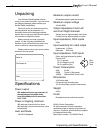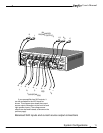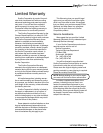
18
User's Manual
• Try moving the speaker cables away from
any power cords. Try just one speaker,
connecting it to different channels and see
if an amplifier channel is bad.
Other causes of noise
• Speaker noise may also be caused by
interference or noise on your AC line.
Make sure there are no large appliances
sharing the line, or halogen lamps or
lamps with dimmer controls.
• Try connecting your system to another AC
socket on a separate line.
• If the hum is heard from within the ampli-
fier and not through the speakers, this may
also be caused by interference on the AC
line. Internal hum can be made worse by a
shelf or cabinet resonating, so try moving
the amplifier to another location.
• Try moving your preamplifier further away
from your amplifier. Sensitive preamp
circuits may pick up hum from the ampli-
fier transformer’s magnetic field.
• Try moving your components further away
from the TV, especially if you ever notice
the screen has changed color in the area
closest to the component.
• If you are still having a problem, remem-
ber that Sunfire’s dealers and technical
support staff will assist you. Make a list of
the things you have tried.
Poor bass performance
• Make sure that your preamp does not
have the bass level turned down.
• Many surround preamplifiers have controls
which can direct all the bass to subwoof-
ers, or let your main speakers play the full
range. Make sure that the preamplifier has
been correctly set. If you are not using a
subwoofer, set the speaker options to
“Large.”
• Check that the speaker wires have been
connected correctly: Make sure that the
positive of each speaker connects to a
positive output of the amplifier, and the
negative of each speaker connects to a
negative output. If one speaker is wired
incorrectly, than it will be “out of phase”
with the others, resulting in poor bass
performance.
• If you have connected the amplifier using
the XLR inputs, make sure that the XLR
cables are wired correctly. If one has the
hot and cold reversed, then this will also
cause a speaker to be out of phase.
No high frequency output
• If you are biamping or biwiring, make sure
that the current source fuses have not
blown.
Troubleshooting


















